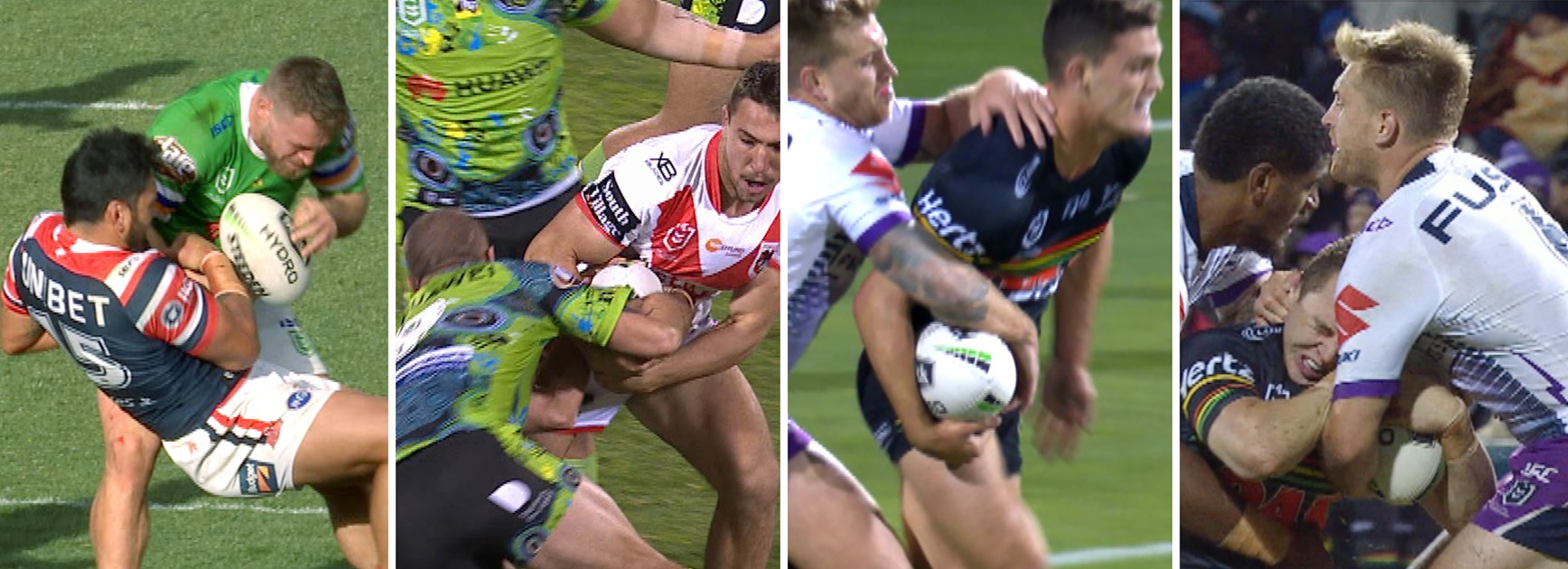
Are you happy with the rule that allows players to perform a one-on-one strip if teammates have dropped off the tackle? NRL.com's experts have had their say on this hot topic.
NRL.com's experts view
Steve Renouf (Maroons legend)
This is a tough one! I'm a fan of the one-on-one strip, however, when there are two or more defenders involved they can and do manipulate the ball carrier. That leaves the player vulnerable to the strip by the defender targeting the ball. So I am not a fan of the rule at it now stands.
Brett Kimmorley (Former NSW halfback)
No. I'm not a fan of the rule once a second player comes into the tackle. One player can stop momentum, the other can go for the ball. The ball runner isn't focussed on retaining the ball, they want a good play the ball. It can be a 2 (or 3) on one tackle. It becomes unfair.
Jamie Soward (Former NSW five-eighth)
No. It is ridiculous. The referees have enough to look out for already and ball carriers have enough to worry about without having to think how many people are touching them at any one time.
Belinda Sharpe: celebrating the women at the heart of rugby league
Zac Bailey (NRL.com reporter)
No. Some players and coaches have (rightfully) exploited the rule beyond what most people would've considered when it was introduced. It has gone too far. Under the old rule there was the rare case of confusion for match officials who may not have been aware if a player had dropped off the ball carrier earlier in the play, but it was generally far less impactful than when 3-4 players are holding a player up, then all bar one drop off and the remaining player rakes the ball.
Joel Gould (NRL.com reporter)
Ball stripping has a great history in rugby league with the late Hugh O'Doherty a master of the art in the 1970s for Valleys Diehards in Brisbane and Broncos great Allan Langer a whiz in the 1990s. I am glad the NRL introduced the rule to allow a one-on-one strip if teammates have dropped off a tackle. The rule brings genuine excitement every time a player runs the ball and re-introduces a contest for possession.
Brett Keeble (NRL.com reporter)
The stripping rule has reintroduced some unpredictability to the game, and some teams have become experts at it. It allows the defensive team to potentially make a contest for the ball in every tackle, which they have been unable to do since striking for the ball in scrums and play-the-balls was effectively outlawed.
Margie McDonald (NRL.com senior reporter)
I like the one-on-one strip – I've seen it change a game. But I don't like how it has become a pre-planned ploy with players dropping off a tackle at the last minute. It is over-used. The one-on-one strip used to be off-the-cuff, a little surprise package coming at an opportune moment. I want the strip to stay – but not the group hug before we get it.
Are we headed for a grand final rematch?
Chris Kennedy (NRL.com reporter)
We have to go back to the one-on-one rule. Teams and players are too good at it now with code words and players dropping off, it's gone a long way past punishing loose carries. There's a reason you can't strip in a three-man tackle and a runner fighting in a tackle doesn't even have time to react in the split second where two tacklers suddenly drop off and the third reefs the ball out. It's also too hard to police for referees.
Jonathan Healy (NRL.com reporter)
I think it's a great rule to allow players the ability to perform a one-on-one strip. Some of the best players in the league can perform the tactic well and I believe it is another skill our best players can utilise.
Tom and Jake Trbojevic join Inside The NRL
Jason Wolfgram (NRL.com reporter)
Yes. And why not? As a tackler, you look for any advantage you can get. If a player isn't holding onto that ball like their life depends on it, then they should expect to lose it. Loose carries in the game are lazy, and this rule keeps players on their toes.
Brad Walter (NRL.com senior reporter)
Yes. I like the stripping rule as it creates another opportunity for the defensive team to gain possession without a stoppage caused by an error or penalty. It also discourages loose carries and players trying to find the ground for a quick play-the-ball.
Maria Tsialis (Big League editor)
I always abide by the "if it ain't broke, don't fix it" rule of life and it applies to the interpretation of a strip. The completely black and white one-on-one situation is enough to add to the drama of the game - if there is more than one person in the tackle at any point, it should be a penalty. There is no room for a grey area on this and I think most referees, players and fans would agree.
Paul Suttor (NRL.com editor)
It's a great rule - the only reason coaches don't want it in the game is it takes away certainty from them as they can't bank on their teams methodically completing sets in robotic fashion. The NRL Fans' Poll proves the supporters love it because it creates greater turnover of possession - the function that scrums used to provide way back when. Attacking players need to have greater ball security.
Mary Konstantopoulos (Ladies Who League)
It's a yes from me for the new stripping rule. It adds excitement in the contest and despite it putting extra pressure on the referees in most cases they've got the call right.
Annesley looking to elimate late shots
Scott Hazlewood (NRL.com reporter)
I don't have an issue with the rule. It creates excitement in the game and can create momentum swings at crucial times. The success some teams have had this year should just promote a greater onus on better ball security from the ball carrier.
Dan Walsh (NRL.com reporter)
Yes. We've seen a rise in one-on-one strips outright as well as the type of strip where other defenders drop off before a tackler has a crack at the ball, and I think that's down to the extra practice teams are putting into it as a genuine tactic, a game-turning one at that.
Tanisha Stanton (NRL.com reporter)
Yes – I don't have a problem with the stripping rule. It adds another element to the game and allows for a good contest around the ruck. It also proves which teams take pride in maintaining possession.
Lone Scout (NRL Fantasy expert)
No. One-on-one strips are fine, but once it becomes any more than that the player with the ball is at a disadvantage. The current rule may also result in players no longer looking for offloads which would stifle attacking play.
Troy Whittaker (NRL.com reporter)
Yes. The rule adds another element of surprise into the game and takes skill. It's still a risk for the defence – ball carriers will quickly realise what's happening and could easily break away from a one-on-one situation after the tacklers drop off.
Every try from Round 21
Tony Webeck (NRL.com reporter)
I’m not a fan and I don't like the influence it has had on the game. I'm all for ball security and attackers having a duty of care to the Steeden but wrestling with three defenders before two coordinate a drop-off to enable a strip to take place is not what the game was built upon. If you commit more than one man to a tackle, your right to play at the ball has been forfeited.
Corey Rosser (NRL.com reporter)
No. It's messy to watch and must be completely confusing for a casual fan. Nobody watches the game to see strips, so why change rules to encourage it?
Kenny Scott (NRL.com podcaster)
Yes. Rugby league's advantage over other sports is its ability to evolve. This is just another step in the evolution of the game. It adds a new element of excitement and unpredictability while allowing the game to flow freely.
The views in this article do not necessarily express the opinions of the NRL, ARLC, NRL clubs or state associations.












